Interview: How to become a sustainable transport heaven
Faela Sufa from the Institute for Transportation and Development Policy (ITDP) in Indonesia and Shreya Gadepalli from ITDP’s programme in India talk about how transport systems can be transformed to make them sustainable and efficient.
Faela Sufa is Deputy Director of the Institute for Transportation and Development Policy (ITDP) in Indonesia, a global non-profit organisation working across the world to promote sustainable modes of public transportation. Shreya Gadepalli leads ITDP’s initiatives in the South Asia region, including India.
Ms Gadepalli, on your daily trip to work, which means of transportation do you use?
 Gadepalli: I live in the city of Chennai, the fourth largest in India with a population of about 10 million. My office is just two and a half kilometres away from home. I often walk to work or take an auto rickshaw, a three-wheeled mini taxi. On my way back, I walk or take a bus, depending on the weather.
Gadepalli: I live in the city of Chennai, the fourth largest in India with a population of about 10 million. My office is just two and a half kilometres away from home. I often walk to work or take an auto rickshaw, a three-wheeled mini taxi. On my way back, I walk or take a bus, depending on the weather.
Could you give a quick overview of the challenges that transportation faces in India?
Gadepalli: With less than a third of all urban trips on personal motor vehicles, less than 10% by personal cars, and more than two thirds by sustainable modes like walking, cycling, and public transport, Indian cities look great on paper – just like a brilliant sustainable transportation heaven. But, the reality on the ground is different. Formal public transport is poor or non-existent. Uncomfortable, unsafe, and polluting paratransit services fill the gap in most cities. Walking and cycling infrastructure are completely missing, or unusable if they exist. People use ‘sustainable’ modes out of financial compulsion, not out of choice. Cities are choked with traffic and pollution. Road fatality rates are 20-25 times that of developed countries.
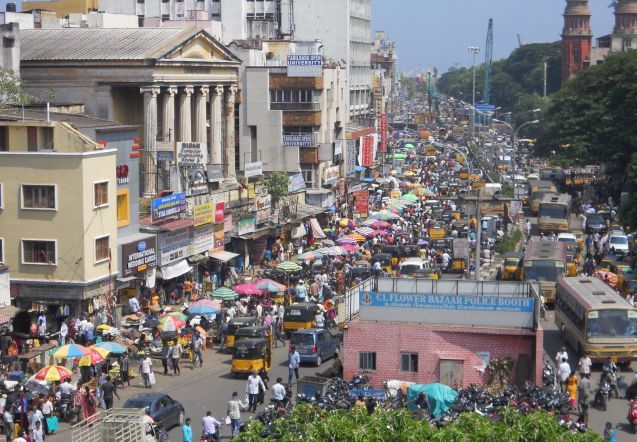
Ms Sufa, what is the situation like in Indonesia?
 Sufa: Development and jobs in Indonesia are still centralised in Jakarta. Every year graduates from universities around Indonesia come to Jakarta to search for opportunities for employment. This situation makes Jakarta one of the largest cities in the world. Housing and transportation has become one of the biggest issues. The skyrocketing house price increase in Jakarta makes people have to live on the outskirts of the city, which will create urban sprawl. In the morning, people travel from the outskirts of Jakarta into the city centre, and after work the traffic pattern is reversed. Jakarta itself has around 10 million inhabitants, but during the day, the population increases to around more than 12 million.
Sufa: Development and jobs in Indonesia are still centralised in Jakarta. Every year graduates from universities around Indonesia come to Jakarta to search for opportunities for employment. This situation makes Jakarta one of the largest cities in the world. Housing and transportation has become one of the biggest issues. The skyrocketing house price increase in Jakarta makes people have to live on the outskirts of the city, which will create urban sprawl. In the morning, people travel from the outskirts of Jakarta into the city centre, and after work the traffic pattern is reversed. Jakarta itself has around 10 million inhabitants, but during the day, the population increases to around more than 12 million.
So how do people in Jakarta get to their office every day?
 To get to the office, people who live outside the city heavily depend on the commuter rail system. If they do not use a private vehicle, people also rely on the Transjakarta bus transit system, which carries around 450,000 passengers per day. But with the boom phenomenon of the online taxi and loose regulation from the government, online motorcycle taxis have become the favourite mode of transport. With the size of the vehicle [motorcycle], which has the flexibility to squeeze through traffic, it has the advantage of bringing the passenger more quickly to their destination. Moreover, the accessibility of the Transjakarta station is still very poor, such as no sidewalk facilities and bad integration with the feeder system.
To get to the office, people who live outside the city heavily depend on the commuter rail system. If they do not use a private vehicle, people also rely on the Transjakarta bus transit system, which carries around 450,000 passengers per day. But with the boom phenomenon of the online taxi and loose regulation from the government, online motorcycle taxis have become the favourite mode of transport. With the size of the vehicle [motorcycle], which has the flexibility to squeeze through traffic, it has the advantage of bringing the passenger more quickly to their destination. Moreover, the accessibility of the Transjakarta station is still very poor, such as no sidewalk facilities and bad integration with the feeder system.
Ms Gadepalli, what is the goal of your IKI project?
Gadepalli: Our goal is to help cities and state governments that play an important role in urban affairs embrace a low-carbon and equitable mobility paradigm. We provide technical support for the creation of appropriate standards and planning methodologies, and developing the rationale for an increase in budgetary allocation towards sustainable modes of transportation. We also help cities in the use of the planning methodologies and standards in developing best practices on the ground. Pune, Chennai and other cities are already creating high-quality footpaths for access to public transportation with our technical support. We are also helping these cities in creating efficient and attractive bus-based rapid transit systems that can provide service quality similar to metro rail or light rail [trams], but at a fraction of the cost and with greater operational flexibility. Our technical support also goes to national institutions like the Indian Roads Congress in developing appropriate urban road planning, design, regulation, and management guidelines and standards. Lastly, our goal is to build the capacity of urban transport practitioners, both within and outside the government, in being able to use the planning methodologies and design standards and processes.
Ms Sufa, which challenges does the IKI project in Indonesia tackle?
Sufa: We still see a lot of opportunity for the public buses. The Transjakarta network currently is 250 kilometres long and actually covers all of the main streets in Jakarta, whereas MRT and LRT, which are still under construction, only cover a few kilometres of passenger journeys. Minibuses, which are individually owned and operate on their own, providing a service which mostly serves smaller or local roads, are still the predominant mode of public transportation in Jakarta. These services have huge potential to become a feeder for the Transjakarta service. If these services are included in the Transjakarta system, not only will it increase the capacity of Transjakarta, but it will also bring closer and better services to the passengers.

First mile and last mile, which can be translated into sidewalk and cycling to access the bus station, is also a major issue of mobility in Jakarta. The sidewalk is being used as a car park or is full of street vendors, which leaves no space for pedestrians. As a cyclist in Jakarta, besides no dedicated cycle lane, they have to compete with buses and other general traffic. They also sometimes have to cycle behind the regular bus [non-Transjakarta buses, which are more than 20 years old], which has a very bad exhaust system.
Is there a high consciousness among citizens or the government for the consequences of transportation regarding pollution?
Sufa: Travel time has become the priority when selecting the transportation mode for the people in Jakarta. But since pollution caused by motor vehicles has become worse, most people have started using masks to protect themselves from air pollution. Not only for motorcycle riders, who are directly impacted by inhaling the fumes from the vehicle exhausts, but pedestrians are starting to use a mask because they also feel disturbed by the air pollution .
Ms Gadepalli, what about India and the consciousness of the people regarding emissions or climate change?
Gadepalli: I would definitely say there is a growing consciousness about emissions — not so much from a climate change perspective but from a local pollution perspective. It affects people every day and they can see that connection. There are, of course, also other factors that do matter to people, like safety. India has one of the worst track records in road safety. Around 150,000 people die every year in road crashes. But more than anything else, people are just frustrated by time lost on transportation in cities and a lack of efficient and accessible mobility options. People aspire to move to personal motor vehicles — first a motorcycle and then maybe a car — because they are being seen as more convenient, and to some, also as a status symbol.

How can you stop the trend to more personal transportation?
Gadepalli: There is now some consciousness about needing to have cleaner modes of transportation. But a lot of people think that the only good quality public transportation is the metro. Every single city in the country, big or small, wants to have a metro system, even if they have few or no city buses operating. They want to jump from nothing to a metro system. However, we have had success in the states that we are working with. Pune announced last year that it plans to double the number of its buses from currently 1,500 to 3,000 buses and continues to expand its bus rapid transit (BRT) system. Chennai is developing plans for an extensive BRT system.
What services do you offer to cities?
Gadepalli: First, we inspire cities by showing them what is possible and how they will benefit. Second, we help them in planning and implementing projects. Third, we provide technical assistance in developing appropriate policy and financing tools. Lastly, we expand the reach through capacity building for wide-scale implementation. Our work includes developing strategic plans that provide overarching guidance, conduct project feasibility studies, and create conceptual designs. For example for Chennai we developed a BRT feasibility plan. Then, we created the terms of reference for the city to hire consultants to develop a detailed plan. Now, we are assisting the public agency to review the plans developed by the consultants and provide technical guidance.
Ms Sufa, how do you foster the cooperation with cities in Indonesia?
Sufa: We come and talk to them and ask them about their plans. Normally they have their own plans so we work together with them. For example, in Jakarta, we work in the public service office on their plan for sidewalks. We give them assistance on the design and priority locations and work day by day with them. We also give suggestions about the budget. Pedestrians are very important, but cities have a limited budget. As a result, we propose setting the priorities for sidewalk improvements within the next budgeting term. In Jakarta, we are developing a design that can be used to implement all sidewalks in the city. The authorities can use it and give it to their consultants. Regarding the budget, we encourage them to do more on improving sidewalks.
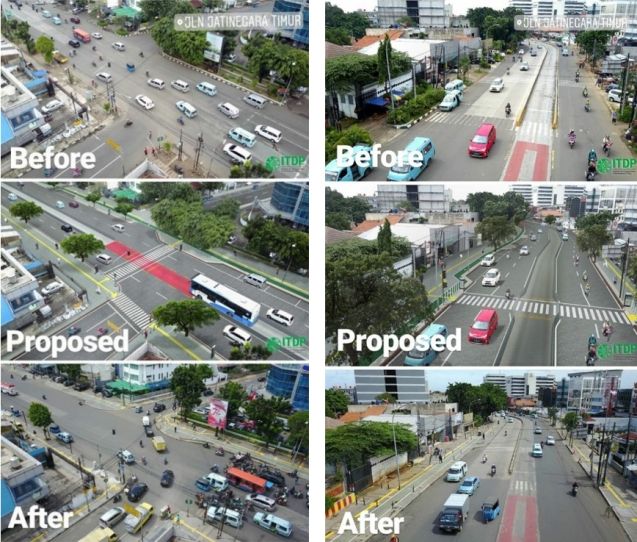
You work together with four cities. How do you approach smaller cities?
Sufa: Normally we find one champion to work with us. For example in Medan, we found a champion who is the head of the local agency and who supports our ideas. He connects us to the other agencies and to the mayor. Medan has two to three million inhabitants but no public mass transit at all. Through our champion, we developed our relationship with other agencies. If they have a plan, for example for a parking system, they ask for our suggestions. We also work on Non-Motorised Transport [NMT] and give suggestions on how to construct the sidewalk along the bus corridors and in the city centre.
We also used the head of the department of sidewalk improvement at the public works of Jakarta to be our spokesperson as she has a lot of experience on sidewalk improvement in Jakarta. She can speak on behalf of ITDP but also from local government to local government. She shares her experience on how to improve the sidewalks in Jakarta, about her difficulties and how she dealt with them.
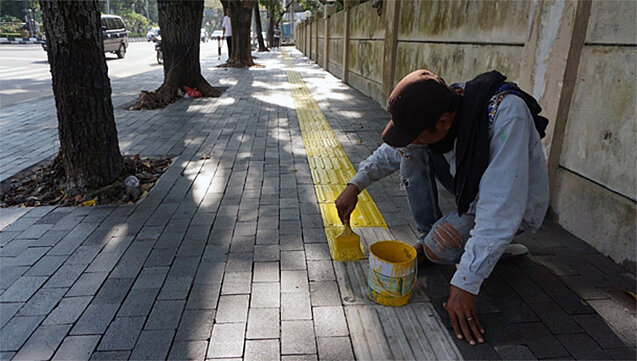
Ms Gadepalli, within your project you also design and implement new and appealing public footpaths. Which role do pedestrians play in public transportation in India?
Gadepalli: Pedestrian access is important from multiple perspectives. Many trips in Indian cities are short. Even in mega-cities like Bombay and Delhi, more than half of the total trips are under five kilometres in length. These are trips that easily could be made using bicycles or even on foot. And if you do not have pedestrian infrastructure, people do not access public transport. Often it is the last mile that is missing and people do not want to put themselves in an unsafe or uncomfortable situation to reach the public transportation. Nearly half of all the deaths that happen in urban areas are pedestrians or cyclists. Good public transport is not sufficient; safe walking is essential for the public transport to succeed. It is an ecosystem where public transport, walking, and cycling come together to provide an alternative means of convenient, safe, and affordable transport for everybody.
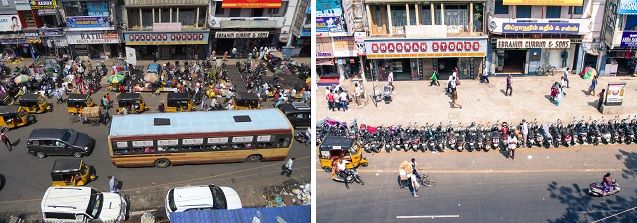
What is your vision for the future?
Currently, 70-80 per cent of people are actually walking, cycling or using public transportation. We have to ensure that these people do not shift to personal motor vehicles and that future residents will also use the sustainable modes of transportation. Between 2011 and 2031, India will have added 230 million people into its cities. And all of them need mobility. Many of the people are young and are coming to join the workforce. Many women who are not currently a part of the workforce will also join. We need to ensure that urban transport is gender-responsive. Earlier this year, we jointly organised a national workshop on Women on the Move; how to ensure that women have better access to transportation within Indian cities. Better transportation allows them to access education and jobs, improve their quality of living, and contribute to the economy.
Ms Sufa – in Indonesia you also started with four cities. Is this just the beginning?
Sufa: Outside Jakarta, we have worked with many secondary cities in Indonesia before, such as Batam, Manado and Palembang. But our scale of work was limited. We delivered basic designs for public transport improvement but we saw that, without any follow-up and plans for implementation, our design will be just become an abandoned working paper.
Therefore, for the cities that we are working with now, mainly for the secondary cities like Semarang and Medan, we are collaborating with the national government and we are pushing the cities to implement our design recommendation to improve mobility in those cities. The main barrier for them to improve the mobility or public transport system is the funding for the infrastructure. The role of the national government is to help them to find funding mechanisms for the infrastructure.
We constantly speak to all the different actors to ensure that they are still on the right track for improving the sustainable public transport system, because transportation is often a political decision. We hope these two cities, Medan and Semarang, can be pilot cities for a public transport system for secondary cities in Indonesia. If we can implement one successful mass transit system in a secondary city, the other ten cities that have similar populations to Medan and Semarang will definitely want to compete.
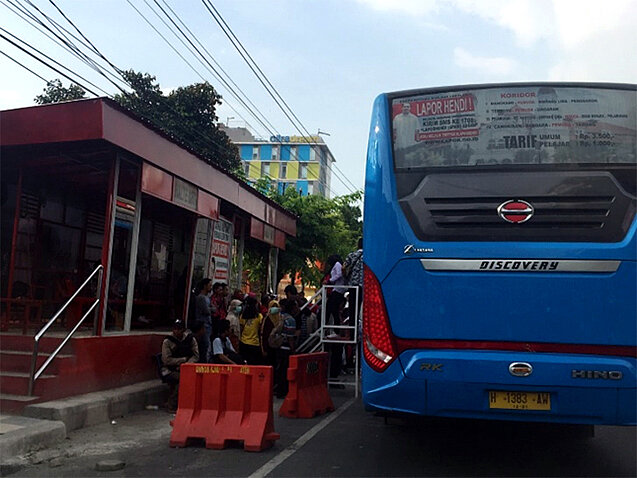
Ms Gadepalli, what are the main factors for the success of your project?
Gadepalli: Our theory of change is relatively simple: first, inspire cities to consider creating best practices. Then, we work with a few cities to create local examples of best practices. Thereafter, we help codify these best practices – in the form of standards, planning methodologies, policy frameworks, and financing tools – through technical assistance to city, provincial, and national agencies. Lastly, we expand the ability of a large majority of cities to implement these things by developing planning and design toolkits and conducting training programmes. Many of the tools that we developed, like a standard street design manual for Pune, have not only been used there but also in other cities. We have helped draft national guidelines on urban road network planning, street design, traffic regulation and bus rapid transit through the aegis of the Indian Roads Congress, a body under the National Ministry of Road Transport and Highways. We are helping multiple states to leverage the national Smart Cities Mission. A training programme is also on the anvil. Through these initiatives, the impact of the IKI programme is not just being felt in a few selected states, but the whole country. That is the power of projects like this.
Ms Sufa, Ms Gadepalli – thank you very much!
The link has been copied to the clipboard
Contact
IKI Office
Zukunft – Umwelt – Gesellschaft (ZUG) gGmbH
Stresemannstraße 69-71
10963 Berlin










![[Translate to English:]](/legacy/_processed_/5/5/csm_Indien_EE_Solar_Frau_bfcf99c425.jpg)





